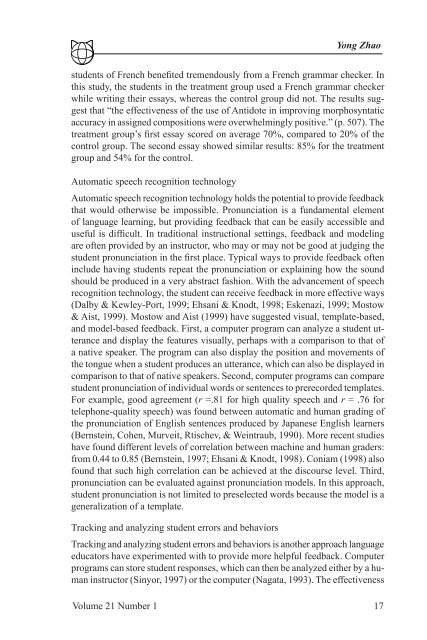Recent Developments in Technology and Language ... - CALICO
Recent Developments in Technology and Language ... - CALICO
Recent Developments in Technology and Language ... - CALICO
Create successful ePaper yourself
Turn your PDF publications into a flip-book with our unique Google optimized e-Paper software.
Yong Zhao<br />
students of French benefited tremendously from a French grammar checker. In<br />
this study, the students <strong>in</strong> the treatment group used a French grammar checker<br />
while writ<strong>in</strong>g their essays, whereas the control group did not. The results suggest<br />
that “the effectiveness of the use of Antidote <strong>in</strong> improv<strong>in</strong>g morphosyntatic<br />
accuracy <strong>in</strong> assigned compositions were overwhelm<strong>in</strong>gly positive.” (p. 50 ). The<br />
treatment group’s first essay scored on average 70%, compared to 20% of the<br />
control group. The second essay showed similar results: 5% for the treatment<br />
group <strong>and</strong> 54% for the control.<br />
Automatic speech recognition technology<br />
Automatic speech recognition technology holds the potential to provide feedback<br />
that would otherwise be impossible. Pronunciation is a fundamental element<br />
of language learn<strong>in</strong>g, but provid<strong>in</strong>g feedback that can be easily accessible <strong>and</strong><br />
useful is difficult. In traditional <strong>in</strong>structional sett<strong>in</strong>gs, feedback <strong>and</strong> model<strong>in</strong>g<br />
are often provided by an <strong>in</strong>structor, who may or may not be good at judg<strong>in</strong>g the<br />
student pronunciation <strong>in</strong> the first place. Typical ways to provide feedback often<br />
<strong>in</strong>clude hav<strong>in</strong>g students repeat the pronunciation or expla<strong>in</strong><strong>in</strong>g how the sound<br />
should be produced <strong>in</strong> a very abstract fashion. With the advancement of speech<br />
recognition technology, the student can receive feedback <strong>in</strong> more effective ways<br />
(Dalby & Kewley-Port, 1999; Ehsani & Knodt, 199 ; Eskenazi, 1999; Mostow<br />
& Aist, 1999). Mostow <strong>and</strong> Aist (1999) have suggested visual, template-based,<br />
<strong>and</strong> model-based feedback. First, a computer program can analyze a student utterance<br />
<strong>and</strong> display the features visually, perhaps with a comparison to that of<br />
a native speaker. The program can also display the position <strong>and</strong> movements of<br />
the tongue when a student produces an utterance, which can also be displayed <strong>in</strong><br />
comparison to that of native speakers. Second, computer programs can compare<br />
student pronunciation of <strong>in</strong>dividual words or sentences to prerecorded templates.<br />
For example, good agreement (r =. 1 for high quality speech <strong>and</strong> r = . 6 for<br />
telephone-quality speech) was found between automatic <strong>and</strong> human grad<strong>in</strong>g of<br />
the pronunciation of English sentences produced by Japanese English learners<br />
(Bernste<strong>in</strong>, Cohen, Murveit, Rtischev, & We<strong>in</strong>traub, 1990). More recent studies<br />
have found different levels of correlation between mach<strong>in</strong>e <strong>and</strong> human graders:<br />
from 0.44 to 0. 5 (Bernste<strong>in</strong>, 199 ; Ehsani & Knodt, 199 ). Coniam (199 ) also<br />
found that such high correlation can be achieved at the discourse level. Third,<br />
pronunciation can be evaluated aga<strong>in</strong>st pronunciation models. In this approach,<br />
student pronunciation is not limited to preselected words because the model is a<br />
generalization of a template.<br />
Track<strong>in</strong>g <strong>and</strong> analyz<strong>in</strong>g student errors <strong>and</strong> behaviors<br />
Track<strong>in</strong>g <strong>and</strong> analyz<strong>in</strong>g student errors <strong>and</strong> behaviors is another approach language<br />
educators have experimented with to provide more helpful feedback. Computer<br />
programs can store student responses, which can then be analyzed either by a human<br />
<strong>in</strong>structor (S<strong>in</strong>yor, 199 ) or the computer (Nagata, 1993). The effectiveness<br />
Volume 21 Number 1 1
















